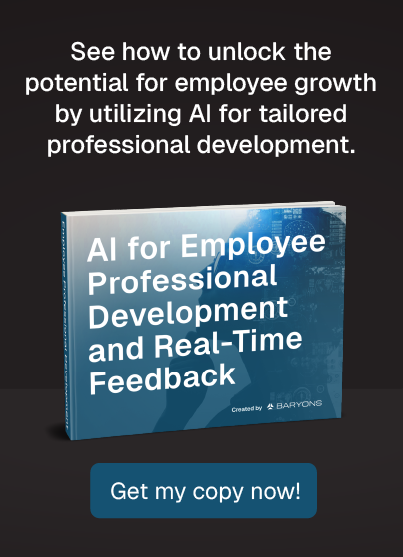
The Real Costs of Losing Employees: Turnover's Impact on Profitability
Organizations are facing a growing employee engagement crisis driven by burnout and a lack of development opportunities. This ever-growing disengagement is quietly undermining productivity, innovation, retention, and ultimately, revenue in growing businesses across the country. Beyond recruitment and training costs, high worker turnover can significantly harm profitability.
Fortunately, understanding the underlying nuances can play a significant role in reducing voluntary turnover in the workplace. This guide also examines its true costs, including loss of productivity, expertise, and morale, along with several solutions to the problem, including how AI mentorship is uniquely positioned to help.
A Breakdown of Costs Due to Losing Employees
Studies show that workers have an average voluntary turnover rate of 13.5% across all industries. Some, however, are much higher than others, including:
- Transportation and Logistics
- Healthcare
- Mining and Metals
- Manufacturing
The cost of above-average turnover can be severe, ranging from half to four times an employee’s salary. This has ultimately led to a loss of $1 trillion in US businesses every year. But the true cost of losing workers goes beyond their salary, as it includes:
- Lost productivity: Studies show that lost productivity and knowledge account for two-thirds of the cost of voluntary turnover. This suggests that losing an above-average number of employees can ultimately lead to an above-average loss of organizational intelligence, strategy, and memory.
- Low morale: It’s an endless cycle. For example, one in four workers leave their jobs due to mental stress, and this lowers the morale of other employees, which increases mental stress, and then the cycle begins anew. The good news is that a greater number of motivated workers may address this.
- Loss of expertise: Losing employees due to turnover or retirement can significantly impact your brand. Approximately 90% of workers say that the loss of a staff member due to retirement contributes to the loss of knowledge and experience in a business. So, unless you have an internal mentorship program in place, you may lose years, if not decades, of priceless knowledge after retirement.
- Disrupted teams: Worker turnover can slow progress and increase workloads, which only contributes further to low morale.
- Damage reputation: Poor reviews on platforms like Glassdoor or Reddit can lower candidate perception. In fact, studies show that 86% of women and 67% of men avoid working for companies with a “bad” reputation.
The good news is that there are ways to avoid these drawbacks.
Solutions to Stop Losing Employees
Studies show that up to 42% of worker turnover can be prevented with the right strategy in place. Here are a few of the simplest ways to avoid voluntary turnover and protect the profitability of your business.
Greater Work-Life Balance
Nearly all HR leaders (or 95%) say that burnout sabotages workforce retention. However, employees who say that they have a better work-life balance are 10% more likely to stay at their company.
Giving workers the freedom to construct their own work-life balance can create an atmosphere of trust and retention in your business. For example, you might work to improve work-life balance by:
- Creating flexible work schedules
- Encouraging hybrid or remote environments
- Organizing health and wellness programs
- Developing a strong company culture around boundaries, vacations, and off-hours communication
Significant Increases in Income or Benefits
Giving employees more incentives via salary and benefits may help increase feelings of loyalty and reduce turnover business-wide. For example, studies show that 54% of actively disengaged respondents would leave their jobs for a salary increase of 20% or less. Another 78% of workers say that they are more likely to stay with their employer because of the benefits.
The actual salary, commission, or benefits package that you offer depends on the position, level, and experience of the employee in question. To determine the right numbers, you can try benchmarking against others in your industry or performing a worker survey to better understand their expectations.
Opportunities That Align With Their Strengths and Passions
Employees who have access to more professional development opportunities are 15% more engaged with their employers and have 34% higher retention rates. This means offering opportunities for upskilling, cross-skilling, and re-skilling has a much larger impact on worker retention than previously thought.
You can also help employees find opportunities for strengths and passions with:
- Volunteer opportunities
- Internal committees
- Organization-wide training days
- Credits to refund conference visits or certifications
Greater Onboarding Experiences
Research suggests up to 69% of workers will stay with a company for at least three years if they have a great onboarding experience. In other words, creating a more robust program for capturing, initiating, and training employees may help ensure their longevity with your company. This might start with engaging training, buddy systems, or icebreaker sessions. You can also adopt software that handles onboarding engagement on your behalf, many of which offer built-in AI features that streamline critical tasks.
AI-Powered Mentorship
AI-powered mentorship can solve the growing employee engagement crisis that's currently eroding productivity, retention, and innovation. AI mentors:
- Deliver personalized support
- Develop careers
- Provide real-time feedback at scale
These benefits can work toward restoring connection, motivation, and purpose across a disengaged workforce. All it takes is selecting the right tool, starting with a program like Baryons.
How to Implement AI Mentorship in Any Business
AI mentors offer a scalable, consistent, and personalized solution to the growing turnover crisis. By integrating AI-powered mentorship and development tools, you can proactively engage employees, provide real-time support, and build growth pathways that retain your strongest hires.
It’s easy to get started with a solution like Baryons: Onboard by allowing users to access their AI mentors via web, phone, text, and chat. Then, sit back and let the AI train employees, streamline workflows, and submit anonymous data that helps benchmark turnover and retention progress for your team.
The $8.8 trillion cost of disengaged employees isn't just a statistic; it's draining your bottom line right now. While your enterprise struggles with distracted staff, costly errors, and customer dissatisfaction, your competitors are solving these problems. At Baryons.ai, we transform employee attention into enterprise profit. Our AI mentor pinpoints focus issues, boosts engagement, and delivers quantifiable productivity gains throughout your organization. Learn how Baryons.ai can leverage your employees' attention to create a competitive edge.
